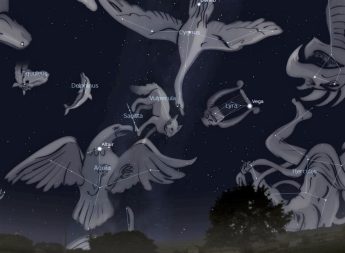This Week’s Sky at a Glance, 2024 Nov 16 – Nov 23
This Week’s Sky at a Glance, 2024 Nov 16 – Nov 23
Like Nate the pirate in the Overboard comics, some people do not want to let go of summer. But you have to accept the inevitable, so around 8:30 pm this week don your coat and imagination to say goodbye to the summer constellations as they sink below the western horizon.
The first thing you might notice is the Summer Triangle, balanced on Altair and tipping to the right. Aquila the Eagle, with Altair at its head, is flapping furiously and futilely to stay above ground, a battle it will lose over two hours. To its right, Hercules is diving head first, hopefully into a lake. Between them, if you are in the country, you might see the haze of the Milky Way spilling over the ground, perhaps to become frost. Four smaller constellations form a line above Altair, highlighted by Lyra to the right with its brilliant star Vega. Foxy Vulpecula, Sagitta the Arrow and eye-catching Delphinus the Dolphin are balanced across the eagle’s wingspan. While you are at it, try for the triangular head of Equuleus the Little Horse, who leads his big brother Pegasus by a nose.
This Week in the Solar System
Saturday’s sunrise is at 7:24 and sunset will occur at 4:53, giving 9 hours, 29 minutes of daylight. Next Saturday the Sun will rise at 7:33 and set at 4:47, giving 9 hours, 14 minutes of daylight.
The Moon is near Jupiter on Sunday and Mars Wednesday, and it is at third quarter on Thursday. This Saturday Mercury is at its greatest elongation from the Sun, appearing low in the southwest and setting an hour after sunset all week. Brilliant Venus can be seen soon after sunset and it sets two and a half hours later. Saturn is at its second stationary point on Saturday, resuming normal eastward motion against the stars. On Wednesday a telescope can reveal Jupiter’s moon Ganymede disappear into the planet’s shadow just before 8:30 pm, and then later observe its Red Spot for two hours before Ganymede reappears from behind Jupiter 18 minutes past midnight. Now brighter than any star except Sirius, Mars is within a binocular view above the Beehive star cluster all week, and it is close enough to Earth to reveal features through a telescope. The Leonid meteor shower peaks Sunday morning, supplemented possibly with stray meteors from the Taurid showers. To complete the solar system trifecta this Saturday, Uranus is at opposition and is a wide binocular-width to the lower right of the Pleiades.
Tune in to the fifth anniversary of the Sunday Night Astronomy Show at 8 pm on the YouTube channel and Facebook page of Astronomy by the Bay.
Weekly Sky at a Glance ~by Curt Nason

